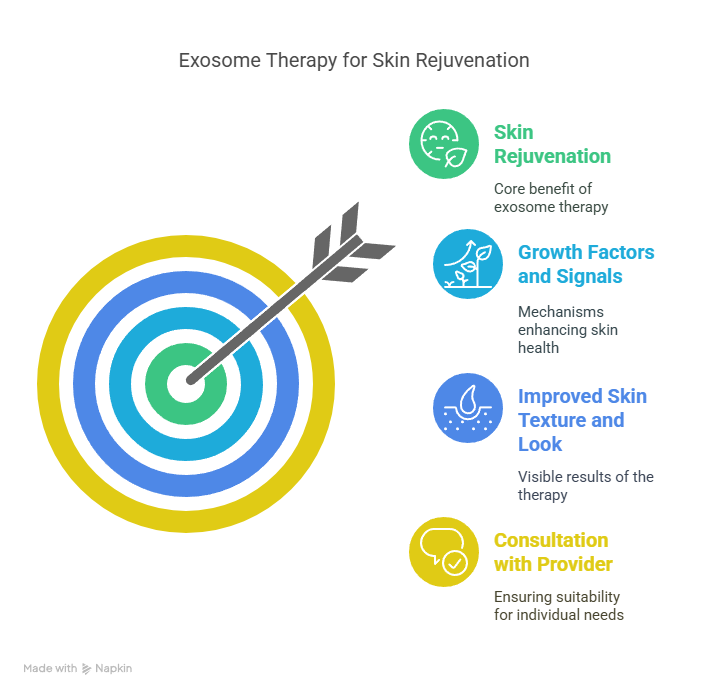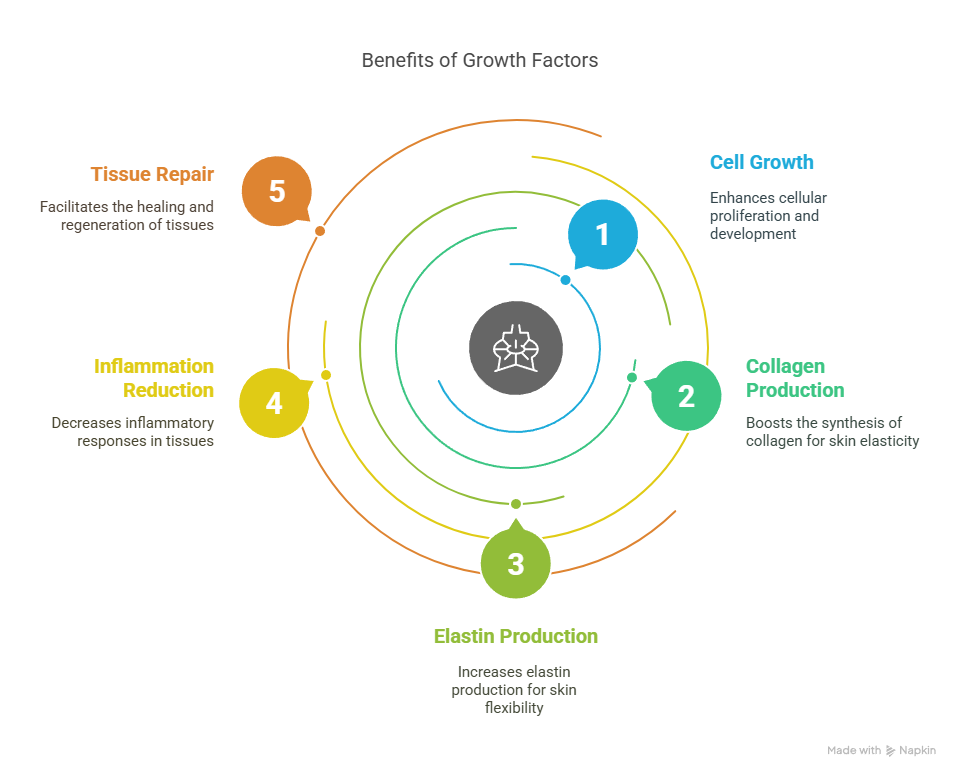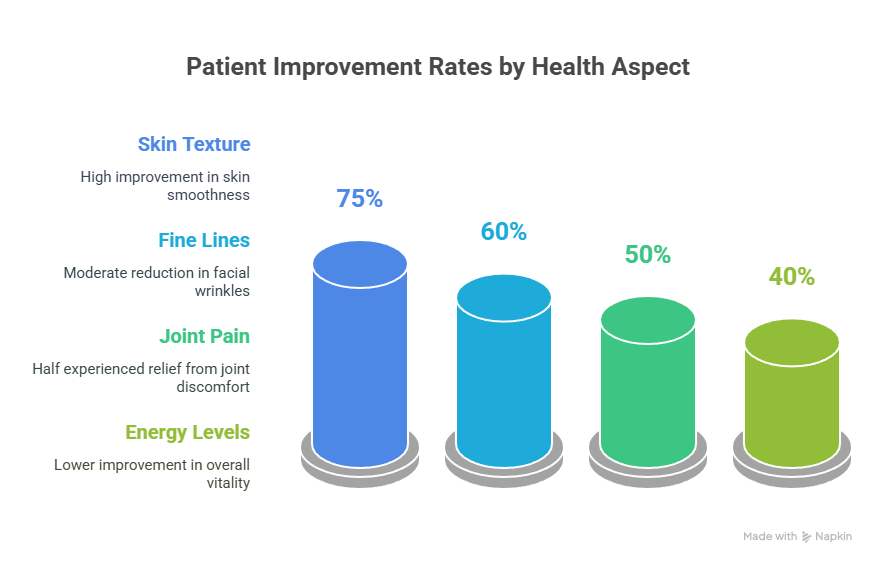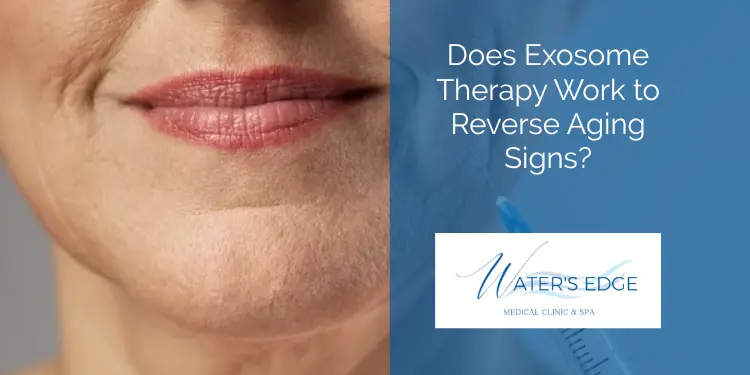Aging is something everyone deals with, and let’s be real, it can be a bit of a downer. From fine lines to sagging skin, those signs of aging can really sneak up on you. But what if there was a way to push back against those changes? Enter exosome therapy. This treatment is gaining attention for its potential to help rejuvenate skin and maybe even slow down the aging process. So, does exosome therapy work? Let’s unpack it together.

Key Takeaways
- Exosome therapy delivers growth factors and signals that can boost skin regeneration and collagen production.
- While it may not completely reverse aging, most users see clear improvements in their skin’s texture and overall look.
- Make sure to speak with a provider to find out if this treatment suits your specific needs.
What Is Exosome Therapy and How Does It Work?
So, what’s all the buzz about exosome therapy? It’s becoming a hot topic, especially when people are looking for ways to turn back the clock. But before jumping on the bandwagon, it’s good to understand what it is and how it’s supposed to work.
Exosome therapy is rooted in regenerative medicine. It’s gaining traction in the aesthetics field because of its potential to rejuvenate skin, speed up healing, and address aging signs at a cellular level. Unlike your typical creams or even PRP, exosomes aim to work deeper. They send signals to cells, encouraging them to produce more collagen, repair damage, and kickstart regeneration from the inside. For those wanting to smooth out wrinkles, improve skin texture, or recover faster after a procedure, exosome therapy is presented as a solution that combines skincare with medical science. But do exosomes really work?
Exosomes are essentially tiny packages released by cells to communicate with each other. They contain proteins, RNA, and other molecules that can influence the behavior of recipient cells. In therapy, these exosomes are used to deliver specific instructions to cells, aiming to repair damage or stimulate regeneration.
Exosomes are extracellular vesicles—tiny particles naturally released by cells that act like messengers. They carry proteins, growth factors, and genetic material that direct other cells to repair, regenerate, and rebuild. When applied topically or injected after treatments like microneedling or laser resurfacing, exosomes amplify your skin’s recovery and regeneration. They stimulate fibroblast activity (key for collagen and elastin production), reduce inflammation, and enhance skin texture and tone at a biological level.
Let’s break it down a bit more:
- Exosomes are like tiny messengers that cells use to talk to each other.
- They carry important cargo, like proteins and genetic material.
- This cargo can tell other cells to repair themselves or do other helpful things.
So, how does exosome therapy work? The idea is that by introducing these exosomes into the body, you can encourage cells to behave in a more youthful and regenerative way. But is exosome therapy safe?
The Science Behind Exosomes and Anti-Aging
Okay, so let’s talk about the science-y stuff behind why everyone’s getting excited about exosomes. It’s not just hype; there’s some real biology happening here. Basically, exosomes are like tiny messengers that cells use to talk to each other. They carry all sorts of important stuff, like proteins and genetic material, and they can tell other cells what to do. Think of them as little delivery trucks carrying instructions for repair and rejuvenation.

In the context of aging, the idea is that exosomes can help kickstart your skin’s natural repair processes. They can boost collagen production, reduce inflammation, and generally encourage cells to behave more like they did when you were younger. Think of it as coaching your skin cells back into action—with a clear game plan. Unlike traditional creams, exosome therapy works deeper.
It’s important to remember that while the science is promising, it’s still relatively new. We’re learning more every day about how exosomes work and how best to use them for anti-aging purposes. Initial outcomes are positive, but more research is required to understand lasting effects.
Here’s a simple breakdown of what exosomes do:
- Deliver growth factors to cells.
- Stimulate collagen and elastin production.
- Reduce inflammation.
- Promote tissue repair.
It’s all about getting those cells to act young again. And that’s the basic science behind the buzz.
Clinical Evidence: Can Exosome Therapy Reverse Aging?
So, can exosome therapy actually turn back the clock? It’s a question on everyone’s mind. While we can’t claim it’s a full-on rewind button, the clinical data is starting to paint a pretty interesting picture. Let’s look at what the studies are showing.
Clinical trials are exploring exosome therapy’s potential to mitigate aging signs, focusing on skin rejuvenation and tissue repair.
There’s a growing body of research, and while it’s still early days, some results are promising. It’s not about immortality, but about improving the quality of life as we age. Think better skin elasticity, reduced inflammation, and maybe even a boost in overall cellular function.
It’s important to remember that exosome therapy is still a relatively new field. Its full safety and effectiveness remain unclear without more comprehensive, long-term studies. However, the initial findings are encouraging, suggesting that exosomes could play a significant role in future anti-aging strategies.
Here’s a quick rundown of what some studies are looking at:
- Skin Wrinkles: Some trials are examining how exosomes affect wrinkle depth and skin texture.
- Hair Growth: There’s research into whether exosomes can stimulate hair follicle regeneration.
- Joint Health: Studies are investigating the potential of exosomes to reduce inflammation and promote cartilage repair in joints.
Real-World Results: What Patients Are Experiencing
It’s one thing to talk about the science behind exosome therapy, but what are people actually experiencing? Let’s get real about what patients are saying after trying this treatment. It’s not always a miracle cure, but there are definitely some interesting trends emerging.

Some people are reporting noticeable changes in their skin. Others are seeing improvements in joint pain. It really seems to depend on the person and what they’re hoping to get out of it.
I’ve heard stories of people feeling like they’ve turned back the clock, but it’s important to keep expectations in check. While promising, exosome therapy is still emerging, and more research is necessary to gauge its long-term safety and results.
Here’s a breakdown of what some patients have shared:
- Skin Rejuvenation: Many report smoother skin texture and a reduction in fine lines. It’s like their skin has a new glow.
- Joint Pain Relief: Some individuals with arthritis have experienced reduced pain and improved mobility. This is a big deal for those struggling with chronic discomfort.
- Faster Healing: Patients undergoing other cosmetic procedures, like laser treatments, have noticed quicker recovery times when combined with exosome therapy.
It’s important to remember that everyone’s experience is unique. What works for one person might not work for another. Factors like age, overall health, and the specific exosome product used can all play a role. Also, the effectiveness of NAD injections can vary based on individual factors.
I’ve compiled some data from patient surveys to give you a clearer picture:
| Improvement Area | Percentage of Patients Reporting Improvement |
| Skin Texture | 75% |
| Fine Lines | 60% |
| Joint Pain | 50% |
| Energy Levels | 40% |
These numbers suggest that exosome therapy shows promise, but it’s not a guaranteed solution. It’s important to stay grounded in your goals and consult a trusted provider before moving forward.
Is Exosome Therapy Right for You? Risks and Considerations
Okay, so you’ve read all about exosome therapy and how it could potentially turn back the clock. Hold up—before you go all in, let’s talk about whether this option actually makes sense for you. It’s not a magic bullet, and like any treatment, it comes with its own set of things to think about.
First off, it’s pretty new. That means we don’t have decades of data on long-term effects. What looks promising now might have some surprises down the road. Also, the quality of exosome products can vary wildly. You want to make sure you’re going to a reputable clinic that uses ethically sourced and properly tested exosomes.
It’s easy to get caught up in the hype, but doing your homework is super important. Talk to your doctor, ask a ton of questions, and make sure you feel comfortable with the clinic and the product they’re using.
Here’s a quick rundown of some key things to keep in mind:
- Cost: Exosome therapy can be expensive. It’s not usually covered by insurance, so you’ll be paying out of pocket.
- Realistic Expectations: It’s not going to make you look 20 again overnight. Results may be mild and often differ from one person to another.
- Potential Side Effects: While rare, there’s always a risk of allergic reaction or infection. Make sure you’re aware of the possible downsides.
For those considering stem cell therapy, exosome therapy is highlighted as a safer alternative. Ultimately, the decision is yours. Just make sure it’s an informed one.
Final Thoughts on Exosome Therapy for Aging
So, what’s the bottom line on exosome therapy? While it might not be a magic fix for aging, it does show promise in helping your skin look and feel younger. This treatment works by boosting your skin’s natural healing and regeneration processes, which can lead to smoother, firmer skin over time. If you’re tired of those fine lines and dullness, exosome therapy could be worth considering. Just remember, it’s not a one-size-fits-all solution. Always chat with a professional to see if it’s right for you. Ready to give it a shot? Your skin might just thank you!
Frequently Asked Questions
What is exosome therapy?
Exosome therapy is a treatment that uses tiny particles called exosomes, which are released by stem cells. These exosomes help your skin heal and regenerate by delivering important signals that boost skin health.
Can exosome therapy really help with aging?
Yes, exosome therapy can help slow down aging signs. By stimulating collagen, it helps your skin repair and regain a fresher, more refined look.
Are there any risks with exosome therapy?
Like any treatment, there can be risks. It’s important to talk to a doctor about your health and any concerns before getting exosome therapy.
Questions? We’re here to help. Reach out to Waters Edge Medical Clinic at 727-550-0855 to schedule your free consultation and find out if exosome therapy is the right choice for you.

